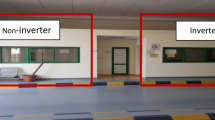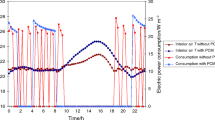Abstract
The combined use of dry cooling (DC) system and dedicated ventilation (DV) system to decouple cooling and dehumidification process for energy efficiency was proposed for subtropical climates like Hong Kong. In this study, the energy performance and condensation risk of the use of DCDV system were examined by analyzing its application in a typical office building in Hong Kong. Through hour-by-hour simulation using actual equipment performance data and realistic building and system characteristics, it was found that with the use of DCDV system, the annual energy consumption could be reduced by 54% in comparison with the conventional system (constant air volume with reheat system). In respect of condensation risk, it was found that the annual frequency of occurrence of condensation on DC coil was 35 h. Additional simulations were conducted to examine the influence of different parameters on the condensation risk of DCDV system. Measures to ensure condensate-free on DC coil were also discussed.
Similar content being viewed by others
References
Ge Gaoming, Xiao Fu, Wang Shengwei. Neural network based prediction method for preventing condensation in chilled ceiling systems [J]. Energy and Buildings, 2012, 45(1): 290–298.
Fong K F, Lee C K, Chow T T et al. Solar hybrid airconditioning system for high temperature cooling in subtropical city [J]. Renewable Energy, 2010, 35(11): 2439–2451.
Binghooth A S, Zainal Z A. Performance of desiccant dehumidification with hydronic radiant cooling system in hot and humid climates [J]. Energy and Buildings, 2012, 51(1): 1–5.
Niu J L, Kooi J V D, Ree H V D. Energy saving possibilities with cooled-ceiling systems [J]. Energy and Buildings, 1995, 23(2): 147–158.
Niu J L, Zhang L Z, Zuo H G. Energy savings potential of chilled-ceiling combined with desiccant cooling in hot and humid climates [J]. Energy and Buildings, 2002, 34(5): 487–495.
Fitzner K. Displacement ventilation and cooled ceilings: Results of laboratory tests and practical installations [C]. In: Proceedings of Indoor Air’ 96. Nagoya, Japan, 1996. 1–41.
Mumma S A. Designing dedicated outdoor air systems [J]. ASHRAE Journal, 2001, 43(5): 28–31.
Murphy J. Dehumidification performance of HVAC systems [J]. ASHRAE Journal, 2002, 44(3): 23–31.
Shank K M, Mumma S A. Symposium on integration of dedicated outside air dehumidification systems and terminal sensible cooling/heating [J]. ASHRAE Transactions, 2001, 1(4): 545–585.
BEAM Society. Building Environmental Assessment Method (BEAM Plus) [M]. BEAM Society, Hong Kong, 2009.
EnergyPlus 6. 0. 0 [EB/OL]. http://apps1.eere.energy.gov/buildings/energyplus, 2009.
Leung Y C. Developing a Condensate-Free Fan-Coil System [D]. Department of Building Services Engineering, The Hong Kong Polytechnic University, Hong Kong, 2009.
Lee W L, Chen Hua, Leung Y C et al. Decoupling dehumidification and cooling for energy saving and desirable space air conditions in hot and humid Hong Kong [J]. Energy Conversion and Management, 2012, 53(1): 230–239.
Jia J, Lee W L. Experimental study of performance of a dry cooling and dedicated ventilation (DCDV) system under different space cooling load conditions [J]. Energy Conversion and Management, 2013, 73(6): 158–166.
Wong W L, Ngan K H. Selection of an example weather year for Hong Kong [J]. Energy and Buildings, 1993, 19(4): 313–316.
Lee W L, Yik F W H, Burnett J. Simplifying energy performance assessment in the Hong Kong Building Environmental Assessment Method [J]. Building Services Engineering and Technology, 2001, 22(2): 113–132.
Author information
Authors and Affiliations
Corresponding author
Additional information
Supported by Competitive Earmarked Research Grant of Hong Kong Government (CERG No. 522709).
Rights and permissions
About this article
Cite this article
Jia, J., Lee, W. Energy performance and condensation risk of DCDV system in subtropical Hong Kong. Trans. Tianjin Univ. 20, 42–47 (2014). https://doi.org/10.1007/s12209-014-2092-2
Accepted:
Published:
Issue Date:
DOI: https://doi.org/10.1007/s12209-014-2092-2




